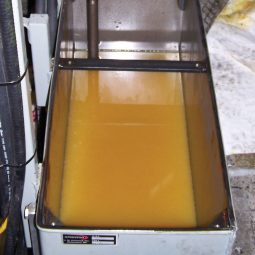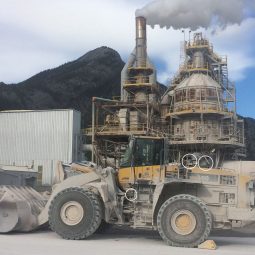Oil does not wear out… it becomes contaminated
 Oil changes are not by choice—they are a necessity. High-pressure hydraulic systems operate in diverse environments under varying loads, leading to different rates of contamination. Because of this, manufacturers provide only recommended oil change intervals. Oil life should be determined by oil sample analysis. Advancements in oil condition monitoring, such as ISO particle count analysis, have transformed maintenance strategies. Regular oil analysis enables tracking of additive depletion, contamination levels, acidity (TAN), and wear debris, helping identify issues before they escalate. High-efficiency filtration further extends oil life, minimizes component wear, and reduces oil change frequency. This improves equipment reliability, lowers maintenance costs, and decreases waste oil disposal, supporting a more sustainable approach. Oil does not wear out—it gets contaminated. Over 80% of hydraulic failures stem from dirty oil. The four main causes of oil degradation are moisture, particulate matter, acid buildup, and oxidation—issues common to all high-pressure systems. By removing water and ultra-fine particles missed by conventional oil filters, contamination levels drop significantly. This reduces the risk of control valve failures, downtime, and frequent oil changes. Keeping oil clean extends service life, improves efficiency, and enhances performance. Maintaining low levels of fine particulates and acidity helps maximize productivity, cut maintenance costs, and drive direct financial savings
Oil changes are not by choice—they are a necessity. High-pressure hydraulic systems operate in diverse environments under varying loads, leading to different rates of contamination. Because of this, manufacturers provide only recommended oil change intervals. Oil life should be determined by oil sample analysis. Advancements in oil condition monitoring, such as ISO particle count analysis, have transformed maintenance strategies. Regular oil analysis enables tracking of additive depletion, contamination levels, acidity (TAN), and wear debris, helping identify issues before they escalate. High-efficiency filtration further extends oil life, minimizes component wear, and reduces oil change frequency. This improves equipment reliability, lowers maintenance costs, and decreases waste oil disposal, supporting a more sustainable approach. Oil does not wear out—it gets contaminated. Over 80% of hydraulic failures stem from dirty oil. The four main causes of oil degradation are moisture, particulate matter, acid buildup, and oxidation—issues common to all high-pressure systems. By removing water and ultra-fine particles missed by conventional oil filters, contamination levels drop significantly. This reduces the risk of control valve failures, downtime, and frequent oil changes. Keeping oil clean extends service life, improves efficiency, and enhances performance. Maintaining low levels of fine particulates and acidity helps maximize productivity, cut maintenance costs, and drive direct financial savings
Contamination Management
 A high-quality oil and standard filter alone will not maximize component life or oil change intervals. Contaminants enter hydraulic systems through various sources. External contamination includes pre-contaminated new oil, airborne dust, and moisture ingress via breathers, cylinder seals, shaft seals, or maintenance procedures. Internal contamination arises as the system wears, generating debris and byproducts over time. Standard high-pressure filters, typically rated at 10 µm (for reference, human hair is 75 µm, and bacteria are 2 μm), struggle to remove water, fine particulate, varnish and metal wear debris. As these ultra-fine contaminants build up, they create a sandblasting effect accelerating erosion, abrasive and adhesive wear, cavitation, fatigue, oxidation, varnish, and sludge formation. When combined with moisture and acid formation, contamination speeds up component degradation, increasing the risk of catastrophic failure. Without effective water and ultra-fine particulate removal, full-flow filters alone cannot maintain optimal oil cleanliness, jeopardizing system reliability. Oil Recycling Technologies™ (ORT) is designed to polish small oil volumes at low flow rates, down to 1 micron, using a precision-wound, multi-ply axial-flow cellulose element that removes ultra-fine contaminants and water missed by conventional filters. Featuring a four-stage filtration process, ORT’s advanced replacement elements (rated at ß₂ = 200) are engineered to meet and exceed Servo Control Valve demands for high accuracy, stability, precise positioning, and fine velocity and acceleration control, making them ideal for hydraulic and high-pressure applications where fluid cleanliness is essential for performance and longevity.
A high-quality oil and standard filter alone will not maximize component life or oil change intervals. Contaminants enter hydraulic systems through various sources. External contamination includes pre-contaminated new oil, airborne dust, and moisture ingress via breathers, cylinder seals, shaft seals, or maintenance procedures. Internal contamination arises as the system wears, generating debris and byproducts over time. Standard high-pressure filters, typically rated at 10 µm (for reference, human hair is 75 µm, and bacteria are 2 μm), struggle to remove water, fine particulate, varnish and metal wear debris. As these ultra-fine contaminants build up, they create a sandblasting effect accelerating erosion, abrasive and adhesive wear, cavitation, fatigue, oxidation, varnish, and sludge formation. When combined with moisture and acid formation, contamination speeds up component degradation, increasing the risk of catastrophic failure. Without effective water and ultra-fine particulate removal, full-flow filters alone cannot maintain optimal oil cleanliness, jeopardizing system reliability. Oil Recycling Technologies™ (ORT) is designed to polish small oil volumes at low flow rates, down to 1 micron, using a precision-wound, multi-ply axial-flow cellulose element that removes ultra-fine contaminants and water missed by conventional filters. Featuring a four-stage filtration process, ORT’s advanced replacement elements (rated at ß₂ = 200) are engineered to meet and exceed Servo Control Valve demands for high accuracy, stability, precise positioning, and fine velocity and acceleration control, making them ideal for hydraulic and high-pressure applications where fluid cleanliness is essential for performance and longevity.